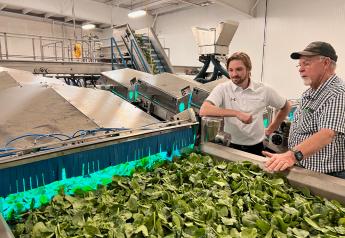FDA proposes redesign of Human Foods Program to enhance coordinated prevention and response activities

Backed by produce industry leaders, the Food and Drug Administration is creating what the agency is calling a “transformative vision” for the FDA Human Foods Program, says Robert Califf, commissioner of food and drugs for the agency.
The backdrop for the announcement includes criticism of the agency’s oversight of baby formula and other issues.
Related news: Expert panel recommends major reforms for FDA
“The agency has carefully reviewed the findings and recommendations from an external evaluation conducted by an expert panel of the Reagan-Udall Foundation that I requested and a separate internal review of the agency’s infant formula supply chain response completed last year,” Califf said in a statement. “The findings and recommendations from these reviews identified issues surrounding culture, structure, resources, and authorities. They also noted several areas of need, including modernizing data systems, providing more resources and authorities, improving emergency response systems, and building a more robust regulatory program.”
Proposed structures for the new FDA Human Foods Program and the Office of Regulatory Affairs (ORA) will have “clear priorities that are focused on protecting and promoting a safe, nutritious U.S. food supply that more quickly adapts to an ever-changing and evolving environment,” Califf said in the statement.
Under the plan outlined by Califf, the functions of the Center for Food Safety and Applied Nutrition (CFSAN), Office of Food Policy and Response (OFPR), as well as certain functions of ORA will be unified into a newly envisioned organization called the Human Foods Program.
The FDA will conduct a competitive national search for a deputy commissioner for human foods, who will oversee the program, according to Califf.
“The person in this position will report directly to me and will be charged with leading a unified Human Foods Program that keeps the foods we regulate safe and nutritious, while ensuring the agency remains on the cutting edge of the latest advancements in science, technology, and nutrition,” he said. “The deputy commissioner will have decision-making authority over policy, strategy, and regulatory program activities within the Human Foods Program, as well as resource allocation and risk-prioritization.”
Califf said other key elements of the proposed new Human Foods Program organization include:
- Creation of a Center for Excellence in Nutrition that prioritizes the agency’s ongoing efforts to help American consumers make more informed food choices, including by working with industry to offer healthier, more nutritious food products. The FDA proposes to establish an Office of Critical Foods, as directed by the 2023 Consolidated Appropriations Act, within this center.
- Establishment of an Office of Integrated Food Safety System Partnerships that will focus on elevating, coordinating and integrating our food safety and response activities with state and local regulatory partners to more effectively meet the vision of an Integrated Food Safety System as envisioned in the FDA Food Safety Modernization Act of 2011. This newly proposed structure will ensure greater collaboration and support of state-level inspectional activities, Califf said.
- To help support the agency’s scientifically grounded decision-making activities, a Human Foods Advisory Committee will be established. Advisory committees are commonly used to obtain independent expert advice on various issues. The Human Foods Advisory Committee will consist of external experts to advise on challenging and emerging issues in food safety, nutrition and innovative food technologies.
- There will be an emphasis on strengthening the FDA’s enterprise information technology and analytical capabilities to fulfill the promise described in the New Era of Smarter Food Safety and support the improvement in workflow that will accompany these changes. This area of focus will support the work of the Human Foods Program by enabling more facile communication, more efficient operations and enhanced empirical risk algorithms to guide the priorities of the program and the work in the field.
As part of this proposed new vision, Califf said the Office of Regulatory Affair’s operating structure will be transformed into an enterprisewide organization that supports the Human Foods Program and all other FDA regulatory programs (such as agency centers) by focusing on its critical activities.
“This realignment will allow ORA to be singularly focused on excellence in its core mission – inspections, laboratory testing, import, and investigative operations,” Califf said. “This will optimize ORA’s operations in line with the FDA’s public health and prevention-oriented goals. Certain other functions of ORA will be aligned in other parts of the FDA to create an overall stronger agency.”
While the FDA’s Center for Veterinary Medicine (CVM) will continue to operate as a stand-alone center, the relevant food safety activities will be closely coordinated between the CVM center director and deputy commissioner for human foods. This proposed structure will allow CVM to support the Human Foods Program where its activities are relevant to human food safety.
The FDA has recently formed an Implementation and Change Management Group that will be charged with developing a detailed plan to ensure the successful execution of this vision, Califf said.
As a next step, he said the FDA will need to develop the vision announced Jan. 31 into a concrete reorganizational proposal in close coordination and communication with internal and external stakeholders while ensuring the agency meets its labor obligations.
While details of the new vision are developed, Califf said the Center for Food Safety and Applied Nutrition, the Office of Regulatory Affairs and the Office of Food Policy and Response will continue to operate under their current structures, with Califf’s direct oversight.
“I look forward to providing additional public updates by the end of February on our progress, organizational design and timeline,” he said in the statement.
Industry support
Jennifer McEntire, chief food safety and regulatory officer for the International Fresh Produce Association, called the news “absolutely a step in the right direction."
“We and many other organizations have been calling for this empowered deputy commissioner for food for about a year,” she said. McEntire said the FDA commissioner has promised more details by the end of February.
She noted industry members have frequent contact with the Office of Regulatory Affairs, and how that organization is changed by the new structure will be of interest to the produce industry.
“I think that it's progress to have one person who's clearly in charge of human foods, who, according to the commissioner’s announcement, would have budget authority and decision rights over the many of the functions of Office of Regulatory Affairs,” McEntire said.
The expectation is, McEntire said, that the Office of Regulatory Affairs would execute based on the priorities that are established by the deputy commissioner for human foods. At the same time, if the deputy commissioner for human foods doesn’t have hiring and firing authority over the Office of Regulatory Affairs, it may limit the powers of the office, she said.
“I think while the structure certainly represents an improvement over where we are today, success will be based largely [on] who this deputy commissioner for human foods is and the leadership team at FDA,” she said. “It's critical to find the right person. I think that have a strong person on charge is going to be a prerequisite for success.”
McEntire said one area where FDA could do a better job in communicating with the industry relates to sampling of produce. Sampling requests can come from the Office of Compliance, the Office of Regulatory Affairs, states and other parts of the agency.
Under the deputy commissioner for human foods, the hope is that there will be increased clarity, transparency and efficiency around sampling requests, McEntire said.
De Ann Davis, senior vice president of science for Western Growers, applauded the FDA announcement.
“We appreciate the commissioner’s consideration of the recommendations of the independent expert panel convened by the Regan-Udall Foundation, as well as the voices of many diverse but united stakeholders in the need to improve the program’s culture of prevention, responsiveness and transparency,” Davis said in a statement. “The fresh produce supply chain needs a strong and engaged FDA to support our nation’s growers and their commitment to continuous improvement of safety, affordability and accessibility of these highly nutritious foods.”
The intent of Congress was clear with the passage of the 2011 passage of the Food Safety Modernization Act, Davis said.
“The FDA is to prioritize preventive actions over reaction,” she said. “We are encouraged by the announced changes, and believe that the addition of a Deputy Commissioner; the creation of an Office of Integrated Food Safety Systems Partnership; a Center for Excellence in Nutrition and a Human Foods Advisory Committee will help support a prevention agenda.”
Davis said there remain critical needs for produce safety:
- Increased state support and authority to assure a strong, sustained prevention agenda for farms.
- Realized commitment to all the pillars of the agency’s stated New Era of Smarter Food Safety.
- Investment in approaches that will rapidly improve a domestic grower’s ability to build upon their food safety prevention strategies, including improvement of the agency’s focus on applied research, outreach, transparency, technical assistance and education.
“Based on today’s announcement, we believe the commissioner and the agency’s senior leaders are focused on the right things to advance the Human Foods Program and perform its congressional mandate more efficiently and effectively,” Davis said. “We remain committed to working with the agency as changes are implemented."
Peter Lurie, president of the Center for Science in the Public Interest, said the FDA’s proposed food program reorganization is a direct attempt to address the well-publicized challenges that program has faced.
“As outlined in our testimony before the Reagan-Udall Foundation Independent Expert Panel, those challenges included a confusing leadership structure, lack of clarity over communications processes, and an agency culture that inadequately emphasizes its food programs, particularly nutrition,” Lurie said.
“By elevating the program to be led by a deputy commissioner, streamlining reporting structures, creating a Center for Excellence in Nutrition, and clarifying the relationship between the Office of Regulatory Affairs and the food program, the agency has confronted each of these issues head on in a manner that is likely to improve efficiency and benefit the American people."







